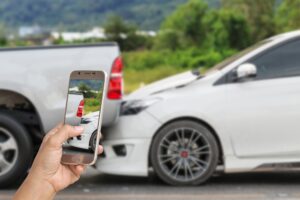Rear-end collisions are one of the most common types of car accidents, accounting for thousands of injuries and deaths each year despite their reputation as minor fender-benders.
Many people believe that a rear-end accident is always the driver’s fault in the following car. While this is true in most cases, there can be other sources of liability, including the lead car’s driver or even the manufacturer that made parts used on the vehicle that malfunctioned. Read on for more information about who pays for rear-end collisions and how fault is determined. a car accident lawyer can guide you in this situation.
Rear-End Accidents: Far More Than a Fender-Bender
As explained by the National Law Review, rear-end accidents are very common. Studies indicate that 29 percent of all crashes resulting in serious injury involve one vehicle rear-ending another. Further, according to the Insurance Information Institute (III), rear-end accidents account for nearly 7 percent of all fatal traffic collisions.
The Most Common Causes of Rear-End Accidents
The National Law Review notes that most rear-end accidents involve one stationary vehicle while the other is moving at speed. Often, the individual in the lead car is completely unaware that a crash is about to occur and cannot take any actions to avoid the accident or brace for the impact.
Some of the actions leading up to a rear-end collision include:
- A distracted driver slamming into the rear of a vehicle that has slowed down or stopped for traffic congestion.
- A driver fails to notice that the vehicle in front of them has its turn signal on and that it is slowing down for a turn.
- The traffic light is yellow, and the driver in the following car wants to beat it, but the driver in front of them chooses to stop.
- A driver anticipates the vehicle in front of them will proceed through the intersection when the light turns green and crashes into the back of the lead vehicle when that doesn’t happen.
Red lights are common areas where rear-end accidents occur, frequently involving more than just two vehicles. For example, suppose vehicles A and B are stopped at the light. The driver of vehicle C fails to realize that traffic has stopped and collides with the rear end of vehicle B. The force of the collision then causes vehicle B to rear-end vehicle A.
Who Pays for a Rear-End Collision?

Generally, when one driver causes an accident that results in physical injuries or property damage to another driver, the driver whose negligent actions caused the accident is legally responsible (liable) for compensating the other party for the expenses and impacts of the harm that was done for them. Those seeking compensation through the personal injury claims process will be required to prove liability and to show documentation of the expenses and impacts they experienced.
To prove liability for a rear-end collision, the claimant and their attorney must show evidence that satisfies the elements of negligence.
These elements include:
- The at-fault driver had a duty to take reasonable actions to avoid causing harm to others on a public roadway.
- Careless or reckless actions by the at-fault driver breached the duty.
- The breach of duty caused a rear-end accident in which the claimant was injured and suffered property damage.
It should be noted that if the rear-end collision occurred due to a chain reaction, such as the red light scenario, all drivers’ actions would be evaluated to determine fault. While the driver of vehicle C is likely to blame for the whole series of events, the actions that the driver of vehicle B could have taken—such as not stopping so closely behind vehicle A at the light will also be considered.
When the Following Car’s Driver Is at Fault
Every scenario listed above as common causes of rear-end collisions is likely the following driver’s fault. Drivers are responsible for following at a distance that allows them ample time to stop if the vehicle in front of them suddenly slows or stops
According to insurance provider Travelers, the National Safety Council recommends that drivers use the three-second rule when following another vehicle. This rule involves choosing a stationary object on the roadside, such as a street sign. The driver notes when the vehicle in front of them has passed the marker and begins counting one-1,000, two-1,000, three-1,000 to see how many seconds it takes for them to pass the same marker.
Additionally, drivers have the responsibility to avoid dangerous or illegal behaviors when using the public roadway, such as distracted driving, alcohol impairment, fatigued driving, and even speeding, which would diminish the time that a driver has to realize that a vehicle has slowed or stopped in front of them and respond appropriately.
When the Lead Car’s Driver Is at Fault
As noted at the beginning of this post, while most rear-end collisions are the following driver’s fault, the lead driver can also cause this type of accident.
Some scenarios that would spell fault for the lead car’s driver include:
- Suddenly stopping in the roadway for no reason. Sometimes, a driver must make a sudden stop, such as when a pedestrian crosses the roadway in their path, a vehicle cuts in front of them, or even a light unexpectedly changes. However, this maneuver can be considered negligent if there is no safety-sensitive reason for stopping during the normal traffic flow.
- The lead car’s driver is traveling in reverse. Many drivers have had the unfortunate experience of missing a turn or realizing that they’ve pulled too far into the intersection and are now unable to make the light, and have responded by putting their car in reverse to get back into the proper lane position for their intended maneuver. If a driver runs into the front of the vehicle behind them, they will commonly be found liable for the accident.
- Before traveling on the roadway, the driver failed to notice that their taillights weren’t working properly, meaning that the driver behind them had fewer visual clues to determine their intentions. Most states and communities have laws that require drivers to ensure that their vehicles have working tail lights. If the cause of the accident involved a traffic law violation, the driver would often be found at fault.
- The driver did not use their turn signal when slowing down to complete a turn. According to a study by the Society of Automotive Engineers, American drivers fail to signal their intentions when turning about 25 percent of the time. Worse: they fail to use their signal when changing lanes about 50 percent of the time.
When a Vehicle Malfunctions
Not all rear-end collisions are the fault of either driver involved. According to a report from Bankrate, more than 13 million vehicles were recalled globally in one recent year due to defects that can compromise safety.
The next year, the NHTSA issued more than 1,000 recalls for safety concerns impacting around 35 million vehicles in a year. Vehicle defects can also be the culprit for rear-end collisions, including defective brakes that can result in a driver being unable to stop the vehicle and defective lights that can fail to provide ample warning to following vehicles.
The claims process will be slightly different when a vehicle malfunction is believed to cause a rear-end collision. Instead of (or in addition to) seeking compensation through a claim filed against the at-fault party’s auto liability insurance, the claimant would file their claim against the business liability insurance of the at-fault manufacturer.
What Will a Claim Against an at-Fault Driver’s Liability Policy Compensate?
Individuals who have been injured and have suffered property damage due to a rear-end collision caused by another driver can seek compensation for the expenses of their accident. This includes all costs associated with medically treating the accident, such as emergency room treatment, surgical services, diagnostic testing, prescription medication, physical therapy, and ambulance transport.
Other expenses that claimants can often seek reimbursement for after a rear-end accident involving injury include the loss of earnings and benefits if the claimant cannot work while recovering from their injury. If the accident results in permanent injuries, they can seek compensation for future lost earning capacity. They can also recover the costs of repairing or replacing the vehicle they were driving when the accident occurred.
As anyone who has ever been injured in an accident can tell you, the psychological impacts of being injured are often as difficult to handle as the expenses of the injury. Consider whiplash, for example, which involves an injury to the neck’s soft tissues, including muscles, tendons, and ligaments. This injury is most often associated with rear-end car accidents.
While the treatment for whiplash is generally not very expensive, the condition can produce symptoms such as neck pain and stiffness, loss of range of motion in the neck, fatigue, dizziness, blurred vision, sleep disturbances, difficulty concentrating, memory problems, depression. These symptoms can last several weeks or even longer for some people and have effects that while usually temporary—are disabling when they are present.
Claimants can also seek compensation for the impacts of the accident on their quality of life. Commonly claimed impacts include physical pain and suffering, emotional distress, loss of enjoyment, and inconvenience.
In rare cases, punitive damages can also be available after a rear-end car accident. Punitive damages are not intended to compensate the victim for expenses or impacts they incurred due to their injury. Instead, they are ordered as a form of financial punishment for drivers who exhibit extreme recklessness leading to an accident, such as driving under a high level of impairment by alcohol or drugs or deliberately trying to crash into another vehicle due to road rage.
Why You Need an Attorney After a Rear-End Accident Injury?

Car Accident Lawyer, Andrew Finkelstein
Through the years, civil court systems have attempted to simplify filing a lawsuit so that those who wish to pursue a claim on their own can do so. Likewise, insurance companies have made the process of filing a claim a matter of filling out an online questionnaire. Despite these efforts, legal processes are not always simple.
Claim processes are also rarely simple. An experienced car accident lawyer has a deep understanding of both processes and can perform the services that generally cause claimants to have an unsuccessful outcome when navigating the personal injury claims process independently.
Some of these services include:
- Determining caused the accident and the insurance policies that all parties have that can compensate you. This can include your policies, such as your personal injury protection coverage, UM/UIM, collision coverage, or even a group health insurance policy you obtained through employment.
- Valuing the claim properly and providing documentation to justify the value to help you secure a settlement or verdict that fully covers the expenses and impacts you incurred.
- Communicating with an at-fault driver’s insurance company to negotiate a fair settlement and avoid having the value of the claim fall victim to insurance company tactics. As nice and well-meaning as claims adjusters seem, they work for an insurance company with a financial interest in paying as little out on claims as possible.
- Ensuring that you file a lawsuit within the statute of limitations to protect your right to use the court to seek compensation if the at-fault party’s insurer fails to offer a fair settlement.
- Presenting the claim in court can involve a lengthy pre-trial process and time to prepare.
- Obtaining the money you recover through a settlement or verdict.
Call a car accident lawyer today after any rear-end accident that injured you so that you can recover the compensation you deserve. Consultations with an attorney are free and carry no obligations, so you can explore your options without risks.
